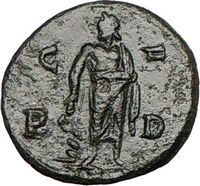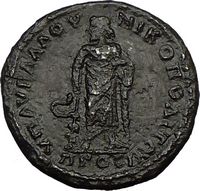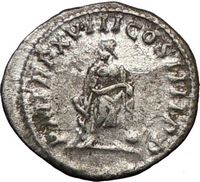Asclepius Ancient Greek / Roman God of Medicine with Serpent Medical
Symbol Staff Coins
Examples of authentic ancient coins available for
sale, click on the search my store for Asclepius link on the left side
for more:



Asclepius (//; Greek: Ἀσκληπιός Asklēpiós [asklɛːpiós]; Latin Aesculapius)
is the god of medicine and
healing in ancient Greek
religion. Asclepius represents the healing aspect of the
medical arts; his daughters are Hygieia("Hygiene",
the goddess/personification of health, cleanliness, and sanitation), Iaso (the
goddess of recuperation from illness), Aceso (the
goddess of the healing process), Aglća/Ćgle (the
goddess of beauty, splendor, glory, magnificence, and adornment), and Panacea (the
goddess of universal remedy). He was associated with the Roman/Etruscan
god Vediovis.
He was one of Apollo's
sons, sharing with Apollo the epithet Paean ("the
Healer"). The rod
of Asclepius, a snake-entwined staff, remains a symbol of
medicine today.
Etymology
The etymology of the name is unknown. In his revised version of Frisk's Griechisches
etymologisches Wörterbuch (Greek
etymological dictionary), R.S.P.
Beekes gives this
summary of the different attempts:
-
"H. Grégoire (with R. Goossens and M. Mathieu) in Asklépios,
Apollon Smintheus et Rudra 1949
(Mém. Acad. Roy. de Belgique. Cl. d. lettres. 2. sér. 45), explains
the name as 'the mole-hero', connecting σκάλοψ,
ἀσπάλαξ 'mole'
and refers to the resemblance of the Tholos in Epidauros and
the building
of a mole. (Thus Puhvel, Comp.
Mythol. 1987, 135.) But the variants of Asklepios and those of
the word for 'mole' do not agree.
-
The name is typical for Pre-Greek words; apart from minor variations
(β for π, αλ(α) for λα)
we find α/αι (a
well known variation; Fur. 335
- 339) followed by -γλαπ- or -σκλαπ-/-σχλαπ/β-,
i.e. a voiced
velar (without -σ-)
or a voiceless
velar (or anaspirated one:
we know that there was no distinction between the three in the substr.
language) with a -σ-.
I think that the -σ- renders
an original affricate,
which (prob. as δ)
was lost before the -γ- (in
Greek the group -σγ- is
rare, and certainly before another consonant); Beekes
Pre-Greek.
-
Szemerényi's etymology
(JHS 94,
1974, 155) from Hitt. assula(a)- 'well-being'
and piya- 'give'
cannot be correct, as it does not explain the velar."
One might add that even though Szemerényi's etymology (Hitt. asula- +
piya-) does not account for the velar, it is perhaps inserted
spontaneously in Greek due to the fact that the cluster -sl- was
uncommon in Greek: So, *Aslāpios would become Asklāpios automatically.
Mythology
Birth
He was the son of Apollo and Coronis. His mother was killed for being
unfaithful to Apollo and was laid out on a funeral pyre to be consumed,
but the unborn child was rescued from her womb. Or, alternatively, his
mother died in labor and was laid out on the pyre to be consumed, but
his father rescued the child, cutting him from her womb. From this he
received the name Asklepios, "to cut open." Apollo
carried the baby to the centaur Chiron who
raised Asclepius and instructed him in the art of medicine.
Wives and offspring

Asclepios with his daughter Hygieia
Asclepius was married to Epione,
with whom he had six daughters: Hygieia, Meditrina (the
serpent-bearer), Panacea, Aceso, Iaso,
and Aglaea, and three sons: Machaon, Podaleirios and Telesphoros.
He also sired a son, Aratus, with Aristodama. The names of his daughters
each rather transparently reflect a certain subset of the overall theme
of "good health".
At some point, Asclepius was among those who took part in the Calydonian
Boar hunt.
Death
Zeus killed
Asclepius with a thunderbolt because he raised Hippolytus from
the dead and accepted gold for it. Other
stories say that Asclepius was killed because after bringing people back
from the dead, Hades thought that no more dead spirits would come to the
underworld, so he asked his brother Zeus to remove him. This angered
Apollo who in turn murdered the Cyclopes who
had made the thunderbolts for Zeus. For
this act, Zeus suspended Apollo from the night sky and
commanded Apollo to serve Admetus,
King of Thessaly for
a year. Once the year had passed, Zeus brought Apollo back to Mount
Olympus and revived the Cyclopes that made his thunderbolts. After
Asclepius' death, Zeus placed his body among the stars as the
constellation Ophiuchus ("the
Serpent Holder").
Some sources also stated that Asclepius was later resurrected as a god
by Zeus to prevent any further feuds with Apollo.
Sacred places
and practices
The most famous temple of Asclepius was at Epidaurus in
north-eastern Peloponnese.
Another famous healing temple (or asclepieion)
was located on the island of Kos,
where Hippocrates,
the legendary "father of medicine", may have begun his career. Other
asclepieia were situated in Trikala, Gortys (in
Arcadia), and Pergamum in Asia.
In honor of Asclepius, a particular type of non-venomous snake was often
used in healing rituals, and these snakes — the Aesculapian
Snakes — slithered
around freely on the floor in dormitories where the sick and injured
slept. These snakes were introduced at the founding of each new temple
of Asclepius throughout the classical world. From about 300 BC onwards,
the cult of Asclepius grew very popular and pilgrims flocked to his
healing temples (Asclepieia)
to be cured of their ills. Ritual purification would be followed by
offerings or sacrifices to the god (according to means), and the
supplicant would then spend the night in the holiest part of the
sanctuary - the abaton (or adyton). Any dreams or visions would be
reported to a priest who would prescribe the appropriate therapy by a
process of interpretation. Some
healing temples also used sacred dogs to lick the wounds of sick
petitioners.
The original Hippocratic
Oath began with
the invocation "I swear by Apollo the Physician and by Asclepius and by
Hygieia and Panacea and by all the gods ..."
Some later religious movements claimed links to Asclepius. In the 2nd
century AD the
controversial miracle-worker Alexander claimed
that his god Glycon,
a snake with a "head of linen" was
an incarnation of Asclepius. The Greek language rhetorician and satirist Lucian produced
the work Alexander
the False Prophet to
denounce the swindler for future generations. He described Alexander as
having a character "made up of lying, trickery, perjury, and malice; [it
was] facile, audacious, venturesome, diligent in the execution of its
schemes, plausible, convincing, masking as good, and wearing an
appearance absolutely opposite to its purpose." Justin
Martyr, a philosophical defender of Christianity who wrote
around 160 AD claimed that the myth of Asclepius foreshadowed rather
than served as a source for claims of Jesus's healing powers. In
Rome, the College
of Aesculapius and Hygia was
an association(collegium) that
served as a burial
society and dining
club that also
participated in Imperial
cult.
The botanical genus Asclepias (commonly
known as milkweed) is named after him and includes the medicinal plant A.
tuberosa or "Pleurisy
root".
Asclepius was depicted on the reverse of
the Greek 10,000 drachmas banknote
of 1995-2001.
Popular culture
- In the short story "The
Two Temples" by Herman
Melville, the narrator, hired by a lady as a personal
physician, describes his job as "the post of private Ćsculapius and
knightly companion."
In Greek
mythology, the Rod
of Asclepius (sometimes
also spelled Asklepios or Aesculapius),
also known as the asklepian, is
a serpent-entwined rod wielded by the Greek god Asclepius,
a deity associated with healing and medicine. The symbol has continued
to be used in modern times, where it is associated with medicine and
health care, yet frequently confused with the staff of the god Hermes,
the caduceus.
Theories have been proposed about the Greek origin of the symbol and its
implications.
Greek
mythology and Greek society
The Rod of Asclepius takes its name from the god Asclepius, a deity
associated with healing and medicinal arts in Greek mythology.
Asclepius's attributes, the snake and the staff, sometimes depicted
separately in antiquity, are combined in this symbol.
The most famous temple of Asclepius was at Epidaurus in
north-eastern Peloponnese.
Another famous healing temple (or asclepieion)
was located on the island of Kos,
where Hippocrates,
the legendary "father of medicine", may have begun his career. Other
asclepieia were situated in Trikala, Gortys (in
Arcadia), and Pergamum in Asia.
In honor of Asclepius, a particular type of non-venomous snake was often
used in healing rituals, and these snakes — the Aesculapian
Snakes — crawled
around freely on the floor in dormitories where the sick and injured
slept. These snakes were introduced at the founding of each new temple
of Asclepius throughout the classical world. From about 300 BC onwards,
the cult of Asclepius grew very popular and pilgrims flocked to his
healing temples (Asclepieia)
to be cured of their ills. Ritual purification would be followed by
offerings or sacrifices to the god (according to means), and the
supplicant would then spend the night in the holiest part of the
sanctuary - the abaton (or adyton). Any dreams or visions would be
reported to a priest who would prescribe the appropriate therapy by a
process of interpretation. Some
healing temples also used sacred dogs to lick the wounds of sick
petitioners.
The original Hippocratic
Oath began with
the invocation "I swear by Apollo the Physician and by Asclepius and by
Hygieia and Panacea and by all the gods ..."
The serpent and the staff appear to have been separate symbols that were
combined at some point in the development of the Asclepian cult. The
significance of the serpent has been interpreted in many ways; sometimes
the shedding of skin and renewal is emphasized as symbolizing
rejuvenation, while other
assessments center on the serpent as a symbol that unites and expresses
the dual nature of the work of the physician, who deals with life and
death, sickness and health. The
ambiguity of the serpent as a symbol, and the contradictions it is
thought to represent, reflect the ambiguity of the use of drugs, which
can help or harm, as reflected in the meaning of the term pharmakon,
which meant "drug", "medicine" and "poison" in ancient Greek. Products
deriving from the bodies of snakes were
known to have medicinal properties in ancient times, and in ancient
Greece, at least some were aware that snake venom that might be fatal if
it entered the bloodstream could often be imbibed. Snake venom appears
to have been 'prescribed' in some cases as a form of therapy.
The staff has also been variously interpreted. One view is that it, like
the serpent, "conveyed notions of resurrection and healing", while
another (not necessarily incompatible) is that the staff was a walking
stick associated with itinerant physicians. Cornutus,
a Greek philosopher probably active in the first century CE, in the Theologiae
Graecae Compendium (Ch.
33) offers a view of the significance of both snake and staff:
Asclepius derived his name from healing soothingly and from
deferring the withering that comes with death. For this reason,
therefore, they give him a serpent as an attribute, indicating
that those who avail themselves of medical science undergo a
process similar to the serpent in that they, as it were, grow
young again after illnesses and slough off old age; also because
the serpent is a sign of attention, much of which is required in
medical treatments. The staff also seems to be a symbol of some
similar thing. For by means of this it is set before our minds
that unless we are supported by such inventions as these, in so
far as falling continually into sickness is concerned, stumbling
along we would fall even sooner than necessary.
In any case the two symbols certainly merged in antiquity as
representations of the snake coiled about the staff are common. It has
been claimed that the snake wrapped around the staff was a species of
rat snake, Elaphe
longissima.
Theories
Some commentators have interpreted the symbol as a direct representation
of traditional treatment of Dracunculus
medinensis, the Guinea
worm. The worm emerges from painful ulcerous blisters. The
blisters burn, causing the patient to immerse the affected area in water
to cool and soothe it. The worm senses the temperature change and
discharges its larva into the water. The traditional treatment was to
slowly pull the worm out of the wound over a period of hours to weeks
and wind it around a stick. The
modern treatment may replace the stick with a piece of sterile gauze but
is otherwise largely identical.
Some commentators have linked the symbol to the Nehushtan,
a sacred object consisting of a serpent wrapped around a pole mentioned
in the Bible in
the Book
of Numbers (Numbers
21:6-9). The section in the
Book of Numbers reads as follows:
Then the LORD sent fiery serpents among the people, and they bit
the people, so that many people of Israel died. And the people
came to Moses and said, "We have sinned, for we have spoken
against the LORD and against you. Pray to the LORD, that he take
away the serpents from us." So Moses prayed for the people. And
the LORD said to Moses, "Make a fiery serpent and set it on a
pole, and everyone who is bitten, when he sees it, shall live."
Moses made a bronze serpent and set it on a pole. And if a
serpent bit anyone, he would look at the bronze serpent and
live.
Modern use

The emergency services' Star
of Lifefeatures a rod of Asclepius
A number of organizations and services use the rod of Asclepius as their
logo, or part of their logo. These include:
Confusion
with the caduceus
It is relatively common, especially in the United States, to find the
caduceus, with its two snakes and wings, used as a symbol of medicine
instead of the correct Rod
of Asclepius, with only a single snake. This usage is
erroneous, popularised largely as a result of the adoption of the
caduceus as its insignia by the U.S.
Army Medical Corps in
1902 at the insistence of a single officer (though there are conflicting
claims as to whether this was Capt. Frederick P. Reynolds or Col. John
R. van Hoff).
The rod of Asclepius is the dominant symbol for professional healthcare
associations in the United States. One survey found that 62% of
professional healthcare associations used the rod of Asclepius as their
symbol. The same survey found
that 76% of commercial healthcare organizations used the Caduceus
symbol. The author of the study suggests the difference exists because
professional associations are more likely to have a real understanding
of the two symbols, whereas commercial organizations are more likely to
be concerned with the visual impact a symbol will have in selling their
products.
The initial errors leading to its adoption and the continuing confusion
it generates are well known to medical historians. The long-standing and
abundantly attested historical associations
of the caduceus with commerce, theft, deception, and deathare
considered by many to be inappropriate in a symbol used by those engaged
in the healing arts. This has
occasioned significant criticism of the use of the caduceus in a medical
context.
|
“ |
As god
of the high-road and the market-place Hermes was perhaps above
all else the patron of commerce and the fat purse: as a
corollary, he was the special protector of the traveling
salesman. As spokesman for the gods, he not only brought peace
on earth (occasionally even the peace of death), but his
silver-tongued eloquence could always make the worse appear the
better cause. From
this latter point of view, would not his symbol be suitable for
certain Congressmen, all medical quacks, book agents and
purveyors of vacuum cleaners, rather than for the
straight-thinking, straight-speaking therapeutist? As conductor
of the dead to their subterranean abode, his emblem would seem
more appropriate on a hearse than on a physician's car. |
” |
|
—Stuart L. Tyson, "The
Caduceus", in The Scientific Monthly |
Standard
representation
The rod of Asclepius has a representation on the Miscellaneous
Symbols table
of the Unicode Standard
at U+2695 (⚕).
See also
|